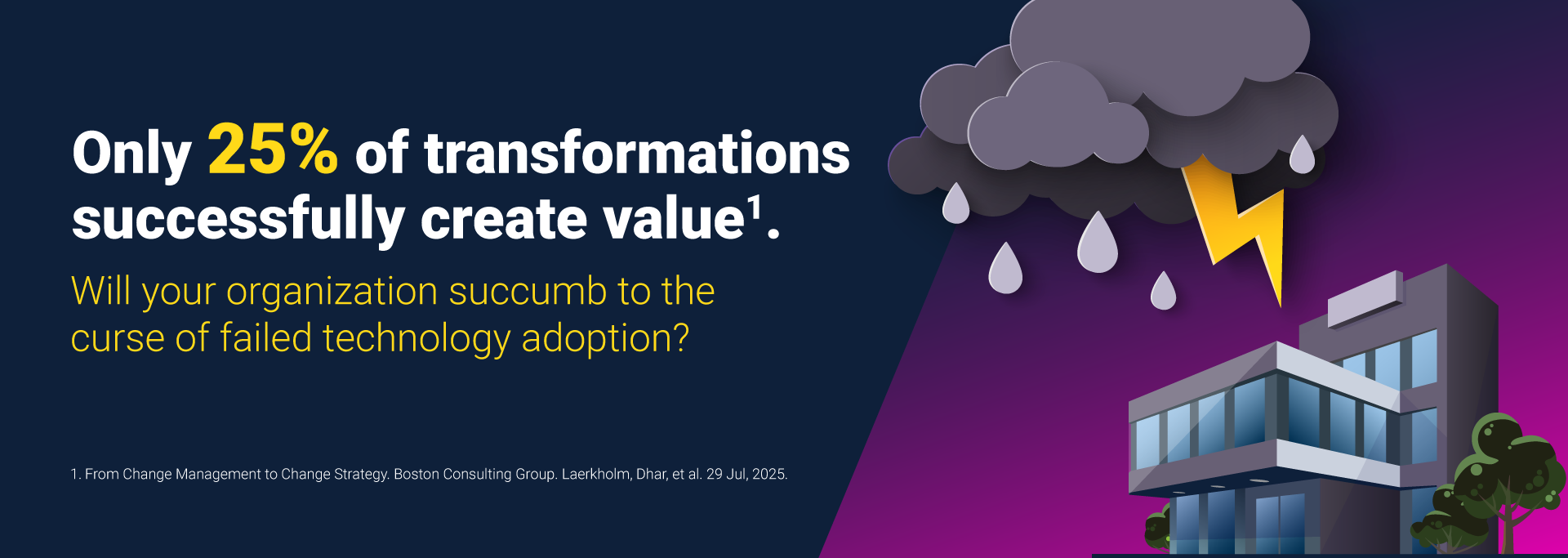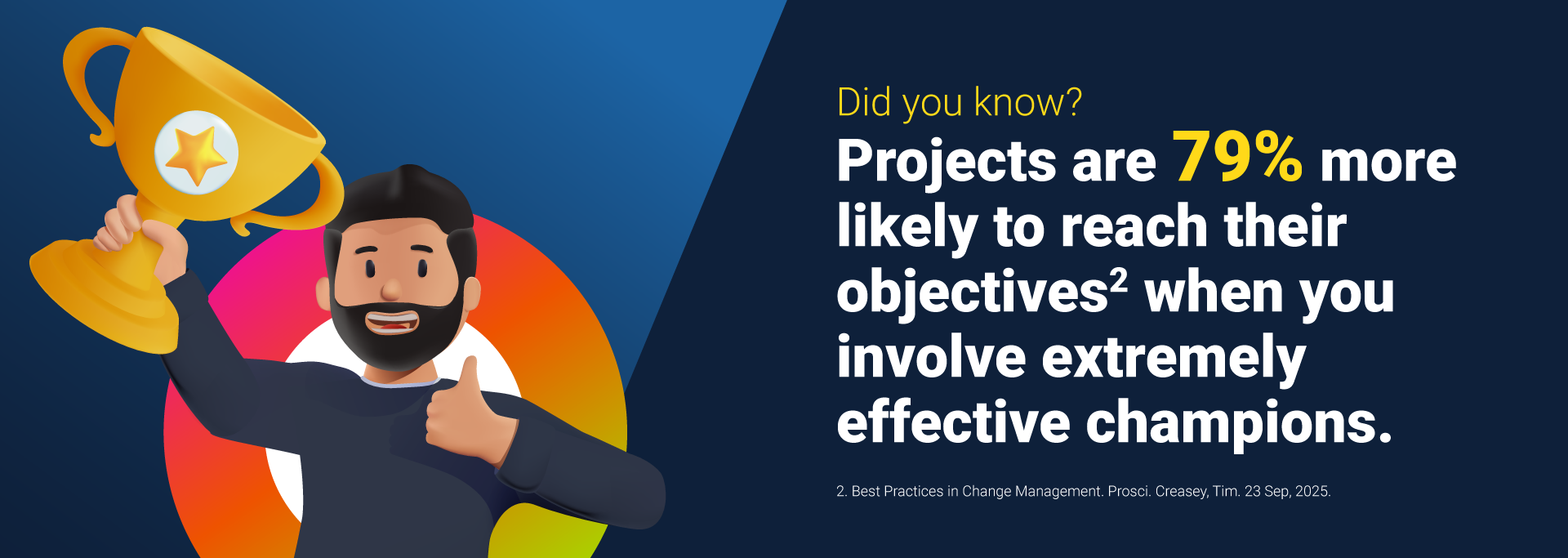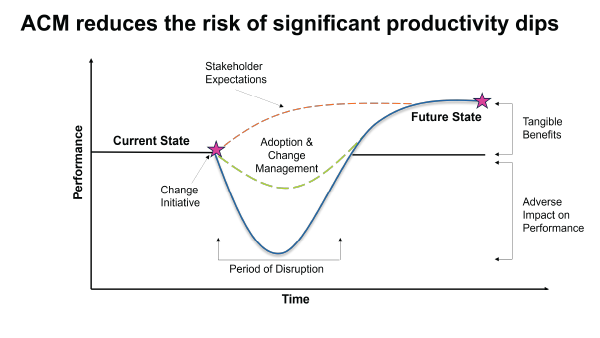How to escape the 75% transformation failure rate cursing IT adoption:
Adoption and change management helps you tackle the people side of change

When technology changes, so too does your workforce. Several years ago, most organizations couldn’t fathom having most of their users work from home. During the shift to remote and hybrid work, even fewer imagined their workdays would soon involve generative and agentic AI.
During periods of change, your success hinges not just on new technology, but also how effectively you adopt and use it. From operating system and software updates to major shifts like migrating from on-premises infrastructure to the cloud, these changes are often necessary for innovation and efficiency. However, for end users, they can easily become a source of disruption and frustration.
So, how can you implement new technologies without adding unnecessary friction? The answer lies in proper adoption and change management (ACM).
Take a structured approach to change management
According to Boston Consulting Group (BCG), only a quarter of transformations successfully create value. To ensure new tech fulfills the promise of a more productive workplace, you need a structured approach to change.

Successful transformations must achieve maximum employee buy-in and seamless adoption. In which of these scenarios is that best accomplished?
Scenario one: You announce the adoption of a new collaboration platform around a month before it goes live. You host a couple of trainings to introduce your users before launch, then sunset your old platform as the new one goes live.
Scenario two: You announce the adoption six months in advance and host tailored trainings for all applicable departments and personas. You also hold weekly virtual office hours to answer questions and run through use cases. When the new platform goes live, users can still access their old platform for a few months to accommodate their data and preferences.
Scenario one may appear to be the most cost-efficient choice in the short term, but it fails to recognize the people side of change. The rapid rollout, meager training, and hasty sunsetting make it unnecessarily difficult for users to learn about and adjust to their new workflow. Because of this, productivity plummets – costing you in the long term.
Prosci’s research reinforces this: the ROI of change management is directly tied to employee adoption and usage. Benefits such as improved data accuracy, reduced errors, and increased performance are only realized when employees embrace new tools and workflows. Projects that neglect the people side of change risk falling short of their objectives, regardless of how advanced the new technology is.
Accelerate change by engaging key stakeholders
Before any rollout, prioritize stakeholder engagement. Frontline leaders, vocal employees, and those with institutional knowledge offer critical insights into operational realities and historical pain points. BCG finds that peer-driven change championed by respected evangelists can lead to faster and broader technology adoption, as these champions help their teams and departments identify the benefits of change.

In fact, further research by Prosci finds projects were 79% more likely to reach their objectives when attached to extremely effective champions.
Live interactions conducted during an initiative, rather than relying solely on surveys, can identify nuanced barriers that affect adoption. These insights inform communication and training plans that resonate with employees and drive real behavior change.
ACM isn’t a phase. It’s a continuous loop
Your work doesn’t end after deployment. Establish feedback loops to monitor adoption, adjust messaging, and refine training. Regular check-ins with pilot users and stakeholders reveal actionable insights, including communication clarity, training relevance, and whether employees feel equipped to succeed. This feedback helps you further support your users and pivot your approach to better tackle their questions and challenges.

Technology adoption often comes with transitional periods during which productivity suffers. With a proper ACM strategy, that risk is significantly reduced.
When the time comes to implement sweeping changes across your organization, are you prepared to guide employees through adoption, or do you expect them to march headlong into the unknown?
ACM equips you with the tools needed to ensure your future initiatives are met with widespread use and goodwill, not confusion and frustration.
Factoring the people side of change and building a team of change champions both make for a great start. Our training and adoption experts help you go even further, maximizing the success of your next IT adoption with proven strategies for achieving buy-in, preparing end users, and rolling out new technology.
NEXT STEPS
Ready to minimize the headaches of your next technology initiative? Learn how SHI can help build a best-in-class ACM strategy. Contact our training and adoption experts to get started.
Lauren Hubbard is a Solutions Architect – Training & Adoption at SHI and has been a Prosci-certified change management practitioner for over 12 years. Lauren supports customers in the adoption of Microsoft technologies — including Microsoft 365 (M365), Teams, and Windows 11 — by aligning digital transformation with user experience. Her change frameworks foster readiness, reduce resistance, and leverage Microsoft’s modern workplace solutions.




